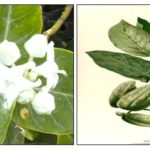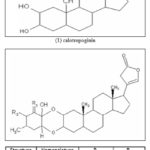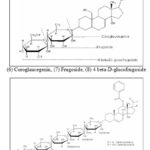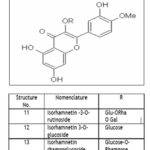CALOTROPIS GIGANTEA: A REVIEW ON ITS PHYTOCHEMICAL & PHARMACOLOGICAL PROFILE
HTML Full TextCALOTROPIS GIGANTEA: A REVIEW ON ITS PHYTOCHEMICAL & PHARMACOLOGICAL PROFILE
Namrata Singh * 1, Piush Gupta 2, Atul V. Patel 3 and A. K. Pathak 2
Government College of Pharmacy 1, Aurangabad - 431005, Maharashtra, India.
Department of Pharmacy 2, Barkatullah University Bhopal - 462026, Madhya Pradesh, India.
Hind Institute of Medical Sciences 3, Safedabad, Barabankee, Lucknow - 225003, Uttar Pradesh India.
ABSTRACT: Calotropis gigantea (Asclepiadaceae) is a perennial herb with a long history of use in traditional medicines. A wide range of chemical compounds including cardiac glycosides, flavonoids, terpenoids, alkaloids, tannins, & resins has been isolated from this plant. The plant has been used for various disease condition including leprosy, ulcers, tumors and piles. Various pharmacological activities reported like analgesic activity, antipyretic activity, pregnancy interceptive activity, CNS activity, anti-inflammatory activity, procoagulant activity, anti-diarrhoeal activity, free radical scavenging activity, antimicrobial activity, anti-tumor activity, antifungal activity, antitussive activity, and antifeedant activity.
| Keywords: |
Calotropis gigantea Linn., Chemical constituents, Pharmacology activity
INTRODUCTION: This plant is distributed throughout India. It is popularly known as arka in Hindi. India being a tropical country is blessed with the best natural resources and ancient knowledge for its judicious utilization. However, to make these remedies acceptable to modern medicine, there is a need to scientifically evaluate them to identify the active principles and understand the pharmacological action 1. Humankind first utilized material found in the environment on an empirical basis to cure various ailments. Natural products from plants and animals traditionally have provided the pharmaceutical industry with one of its important sources of lead compounds in search of new drugs and medicines.
The search for new pharmacologically active agents from natural resources such as plants, animals, and microbes led to the discovery of many clinically useful drugs 2.
Calotropis gigantea (Giant milk-weed):
Botanical name : Calotropis gigantea Linn.
Family : Asclepiadaceae
Hindi : Ag, Akan Ark, Madar
Sanskrit : Arka, Aditya, Mandara
Marathi : Akand, Lal
Part used : Leaves, root, root bark, latex, stem bark, flowers.
Distribution: Throughout India, Ceylon-Malay Island, S. China.
Botanical Description: A tall shrub reaching 2.4-3m high; back yellowish white, furrowed; branches stout, terete, more or less covered (especially the younger ones) with fine appressed cottony pubescence. Leaves 1-20 by 3.8-10 cm, sessile or nearly so, elliptic-oblong or abovate-oblong, acute, thick, glaucous-green, clothed beneath and more or less above with fine cottony tomentum; base narrow, cordate. Flowers inodorous, purplish or white. Calyx divided to the base; sepals 6 by 4 mm, ovate, acute, cottony. Corolla 2 cm long or more; lobes 1.3-1.6 cm long, deltoid-ovate, subacute, revolute and twisted in age; lobes of the corona1 3cm long by 5 mm pubescent on the slightly thickened margin, the apex rounded with 2 obtuse auricles just below it. Follicles 9-10 cm Long, broad, thick, fleshy, ventricose, green. Seeds numerous, 6 by 5 mm, broadly ovate, flattened narrowly margined, minutely tomentose, brown coma 2.5-3.2 cm long 3, 4.
Chemical Constituents:
Root: cardiac glycosides, seven oxypregnane-oligo glycosides, calotroposides A-G. Root bark: β-amyrin, two isomeric crystalline alcohols, giganteol, isogiganteol, and cardenolides. Latex: akundarin, latex contains 0.45% uscharin, 0.15% calotoxin, 0.15% calactin, latex also contains α-calatropeol, β- calotropeol, β-amyrin and calcium oxalate, it also yields a nitrogen and sulphur containing fish and cardiac poison, gigantin. Latex also contains traces of glutathione and a proteolytic enzyme similar to papain. Leaves: alkaloids, glycosides, mudarine. Stembark: β-calotropeol, β-amyrin, giganteol. Flower: nα-calatropeol, β-calotropeol, amyrin, cardioactive glycosides, mudarine, asclepin, bitter resins akundarin, calotropin 4-8.
Therapeutic Uses: The plant is purgative, anthelmintic, alexipharmic, cures leprosy, leucoderma, ulcers, tumors, piles, diseases of the spleen, the liver, and the abdomen; the juice is anthelmintic and leucoderma, tumors, ascites, diseases of the abdomen. The leaves are applied to paralyzed parts, painful joints, swellings; heal wounds. The tincture from the leaves used as antiperiodic in cases of intermittent fevers 3, 4.
Inflammations, tumors, rat-bite, good in ascites. The milk is bitter, heating, purgative; Laxative; cures piles. The root bark is diaphoretic; cures asthma and syphilis. The flower is sweet, bitter, anthelmintic, analgesic, astringent, cures.
FIG. 1: CALOTROPIS GIGANTEA PLANT
Phytochemistry: Phytochemically the plants have been investigated for cardenolides from the latex and leaves, 9, 10 triterpenoids, 10 anthocyanins from flowers 11 and hydrocarbons 12. The leaves and latex of Calotropis gigantea were found to have cardiac glycosides, various glycosides were isolated and studies 13. An active principle ‘mudarine’ was isolated from leaves of C. gigantean. Beside this, a yellow bitter acid and resin were also found. The cardiac glycosides were identified as Calotropogenjn (1), calotropin (2), Uscharin (3) and Calotoxin (4), Calactin (5) 10, 14. Three cardenolide glycosjdgs. Coroglaucigenn (6), frugoside (7), and 40 befaglucopyranosylfrugoside (8), were obtained as the cytotoxic principles of "akond mul" (roots of Calotropis gigontea L.). The cytotoxicity of these compounds against various cell lines of human and mouse origin was tested. They showed similar cell line selectivity to those of cardiac glycosides such as digoxin and ouabain. They are toxic to cell lines of human origin, but not to those from mouse Two new oxypregnane-oligo-glycosides named calotroposides A (9) and (10) have been isolated from the root of C. gigantea, an Indonesian medicinal plant, and their chemical structures have been elucidated by chemical and spectroscopic methods micrograms/ml 15. Pal studied crystallization and properties of calotropin DI and DII from C. gigantean 16.
12-0-benzoyl diacetyl metaplexigenin 3-0-beta-D-cymaropyranosyoleandropyranosyl (1-4)- beta- D-oleandropyranosyl (1-4)- beta- D- cymaro pyranosyl (1-4)- beta-D-pyranoside, respectively 17. Besides isolation and characterization of iso-rhamnetin- 3-O-rutinoside (11), isorhamnetin glucopyranoside (12) and taraxasteryl acetate, a new flavonol trisaccharide was isolated from the aerial parts of C. gigantea, and its structure was established as isorhamnetin- 3- 0- (2-0-beta-D- galactopyranosyl- 6- O-alpha-L-rhamnopyranosyl)- beta- D-glucopyranoside (13) by a combination of fast atom bombardment mass spectroscopy, 'H and "C NMR spectra and some chemical degradations 18.
Giganticine, a novel non-protein amino acid, has been isolated from a methanol extract of the root bark of Catotropis gigantea and its structure established by spectroscopic methods. It exhibited significant antifeedant activity against nymphs of the desert locust Schistocerca gregaria 19. Two proteinases containing carbohydrate, called calotropin-FI and calotropin-FII, were purified from Calotropis gigantea latex by CM-Sephadex C-50 chromatography. Both calotropain-FI and Fll were found to homogeneous by chromatography 20.
Pharmacological Profile:
- Studies on the Antidiarrhoeal Activity of Calotropis gigantea in Experimental Animals: The anti-diarrheal effect of hydroalcoholic (50:50) extract of aerial part of Calotropis gigantea was studied against castor oil-induced-diarrhea model in rats. The gastrointestinal transit rate was expressed as the percentage of the longest distance traversed by the charcoal divided by the total length of the small intestine. The weight and volume of intestinal content induced by castor oil were studied by enteropooling method 21.
- Evaluation of the Antipyretic Activity of Calotropis gigantea in Experimental Animals: The roots of Calotropis gigantea have been used in leprosy, eczema, syphilis, elephantiasis, ulceration, and cough in the Indian system of traditional medicine. The present communication TAB (Typhoid) vaccine-induced pyrexia in rats and rabbits. In both yeast-induced and TAB vaccine-induced fever, the fever was significantly reduced, and the body temperature was normalized by administration of 200 and 400 mg/kg dose intraperitoneally.
Based on the results of the present study it can be concluded that the extract of C. gigantea has potential antipyretic activity against both yeast-induced and TAB vaccine-induced fever, indicating the possibility of developing C. gigantea as a cheaper and potent antipyretic agent 22.
- Procoagulant Activity of Calotropis gigantea latex Associated with Fibrin (ogen) Olytic Activity: The crude latex extract contained many proteins, which are highly basic and exhibited strong proteolytic activity. The crude extract hydrolyzes casein, human fibrinogen, and crude fibrin clot in a dose-dependent manner. The hydrolyzing activity was completely inhibited by IAA indicating they belong to the super family, cysteine proteases. Crude extract hydrolyzes Alpha, Beta and gamma subunits of fibrinogen. Among all the subunits the preferential subunit to get hydrolyzed was Alpha followed by Beta and gamma subunit is highly resistant and hydrolyzed at higher protein concentration or over prolonged incubation time. The crude extract hydrolysis crude fibrin clot strongly compared to trypsin and papain. Pharmacologically the crude extract is hemorrhagic and induces skin hemorrhage at >75 microns and reduces coagulation time of citrated plasma from 150 to 47 s and promotes blood coagulation 23.
- Pregnancy Interceptive Activity of the Roots of Calotropis gigantea Lin in Rats: The ethanolic extract of the roots of C. gigantea Linn. exhibited 100% pregnancy interceptive activity in rats when administered as a single oral dose of 100 mg/kg on Day 1 postcoitum. The extract also exhibited 100% efficacy at the dose of 12.5 mg/kg when administered in the Days 1-5 and 1-7 postcoitum schedules.
When administered during the pericum-early post-implantation period (i.e., Days 5-7 postcoitum at 250 mg/kg), most of the implantations showed signs of resorption 24.
- A Novel Insect Anti-feedant Non-protein Amino Acid from Calotropis gigantea: Giganticine (1), a novel non-protein amino acid, has been isolated from a methanol extract of the root bark of Calotropis gigantea and its structure established by spectroscopic methods. It exhibited significant anti-feedant activity against nymphs of the desert locust Schistocerca gregaria 25.
- Cytotoxic Principles of a Bangladeshi Crude Drug, Akond Mul (Roots of Calotropis gigantea): Three cardenolide glycosides, calotropin (1), frugoside (2), and4'-O-b Dglucopyranosylfrugoside (3), were obtained as the cytotoxic principles of "akond mul" (roots of Calotropis gigantea L.). The cytotoxicity of these compounds against various cell lines of human and mouse origin was tested.
They showed similar cell line selectivity to those of cardiac glycosides such as digoxin and ouabain: they are toxic to cell lines of human origin, but not to those from the mouse at 2 micrograms/ml 26.
- CNS Activity of Calotropis gigantea Roots: Alcoholic extract of peeled roots of Calotropis giganteaBr. (Asclepiadaceae) was tested orally in albino rats at the dose level of 250 and 500 mg/kg bodyweight for CNS activity. Prominent analgesic activity was observed in Eddy's hot plate method and acetic acid-induced writhings. The paw licking time was delayed, and the numbers of writings were greatly reduced. Significant anticonvulsant activity was seen as there was a delay in the onset of pentylenetetrazole-induced convulsions as well as a decrease in its severity. The extract treated rats spent more time in the open arm of EPM showing its antianxiety activity. There was a decrease in the locomotor activity. The fall off time (motor coordination) was also decreased. A potentiation in the pentobarbitone-induced sleep due to the sedative effect of the extract was observed. No mortality was seen up to the dose of 1 g/kg. These results show the analgesic, anticonvulsant, anxiolytic and sedative effect of the extract 27.
- Analgesic Activity of Calotropis gigantea Flower: The alcoholic extract of the flowers of Calotropis gigantea was administered orally and explored for its analgesic activity in chemical and thermal models in mice. In acetic acid-induced writhing test, an inhibition of 20.97% and 43.0% in the number of writhes was observed at the doses of 250 and 500 mg/kg, respectively. In the hot plate method, the paw licking time was delayed. The analgesic effect was observed after 30 min of dose administration which reached its maximum after 90 min 28.
- Evaluation of Anti-inflammatory Activity of Calotropis gigantea in Various Biological Systems: The anti-inflammatory activity was evaluated using carrageenin-induced kaolin -induced rat paw edema for acute and cotton-pellet granuloma, adjuvant-induced arthritis model for chronic inflammation. Antipyretic activity was carried out using yeast induced pyresis method. Phenylquinone an induced writhing method in mice was used for the analgesic activity. Test compounds exhibited variable anti-inflammatory activity, and peak activity of the test compounds was reached at 2 h. Alkaloid fraction possesses comparatively high initial anti-inflammatory activity.
The residual anti-inflammatory activity of alkaloid fraction of Calotropis gigantea suggests either a greater malic enzyme of a filarial worm Setaria digitata: some properties and effects of drugs and herbal extracts. Mitochondrial malate dehydro-genase (mMDH) and malic enzyme (mME) of a filarial worm Setaria digitata were studied. The leaf extracts of Ocimum sanctum, Lawsonia inermis and Calotropis gigantea and leaf and flower extracts of Azadirachta indica were, however, found to inhibit both mMDH and mME 32.
- Effect of Plant Extracts and Systemic Fungicide on the Pineapple Fruit-Rotting Fungus, Ceratocystis paradoxa: Antifungal activities of extracts of sixteen plants were tested against Ceratocystis paradoxa which causes soft rot of pineapples. Xanthium strumarium was the most effective followed by Allium sativum.
The effectiveness of various extracts against C. paradoxa was in the decreasing order of Meriandra bengalensis, Mentha piperita, Curcuma longa, Phlogacanthus thyrsiflorus, Toona ciliata, Vitex negundo, Azadirachta indica, Eupatorium birmanicum, Ocimum sanctum, and Leucas aspera. Extracts of Cassia tora, Gynura cusimba, Calotropis gigantea, and Ocimum canum showed fungitoxicity 33.
- Evaluation of Chemical Constituents and Free-Radical Scavenging Activity of Swarnabhasma (Gold Ash), an Ayurvedic Drug: In the present investigation, Swarnabhasma was prepared after proper purification and calcination as per Ayurvedic pharmacy which consisted of Realgar (As2S2), Lead oxide (Pb3O4), Pure gold (Au) and Latex of Calotropis gigantea 34.
- Hepatoprotective Activity: Methanolic extract of gigantea leaf is having good hepatoprotective activity in a dose dependent manner against CCl4 induced hepatotoxicity in rats 35.
- Antitussive Activity: leaf extract showed antitussive activity due to the presence of alkaloids and glycosides 7.
- Free Radical Scavenging Activity: The ethanolic extracts of leaf and latex of Calotropis procera and Calotropis gingantea (Asciepadiacea) were tested of free radical Scavenging activity using 1,1 Diphenyl Picryl hydrazyl radicals. The latex extracts of procera and C. gigeantea (10 mg/ml) exhibited the greater capacity to scavenge DPPH radicals whereas leaf extract showed moderate free radical scavenging activity 36.
- Anti-inflammatory Activity: to evaluate the effect of Calotropis gingantea in various experimental animal models. The anti-inflammatory activity was evaluated using carrageenin-induced kaolin-induced rat paw edema for acute and cotton-pellet granuloma, adjuvant-induced arthritis model for chronic inflammation. Anti-pyretic activity was carried out using yeast induced pyresis method 37.
ACKNOWLEDGEMENT: Nil
CONFLICT OF INTEREST: Nil
REFERENCES:
- Vaidya A: Pharm Res. India (Pharma Pulse – Suppl), 1998; 44-45.
- Haslam EJ and Nat: Prod. 59, 1996; 205-215.
- Kirtikar KR and Basu BD: Indian medicinal plants, Vol. III, 1995, National book distributors, Dehradun 1607-1609
- Anonymous: “The Wealth of India,” Vol. III, Publications and Information Directorate, CSIR, Delhi 1998; 78
- Compendium of Indian medicinal plants”, Vol IV, Rastogi and Mehrotra, PID, New Delhi 1990; 136, 381.
- Chopra RN. Nayar SL and Chopra IC: “Glossary of Indian Medicinal Plants”, CSIR, New Delhi 1999; 46-47.
- Bhattarai: Int J Pharmacog. 1994; 32, 13; chem. Abstr, 1994, 121: 73496.
- “Compendium of Indian medicinal plants”, Vol. III, Rastogi, and Mehrotra, PID, New Delhi, 1990; 118.
- Crout G: Tetrahedron 1962; 26: 1281-1285.
- Seiber N, Carolyn J, Nelson J and Lee M: Phytochemistry 1998; 9: 2343-2348.
- Tiwari: Vigyan Parishad Anusandhan Patrika 1978; 21: 177-178.
- Carruthers IB: Biomass 1984; 4: 275-282.
- Tatsuo Y and Fumiko A: Tetrahedron Letters 1852; 28.
- Chaudhary HN: Bull. Bot. Surv. India 1961; 3(2): 171-173.
- Kiuchi F, Fuakao Y, Maruyoma T, Obata T, Tanaka M. Sassaki T, Mikage M, Haque ME and Tsuda Y: Chem Pham Bull 1998; 46(3): 528-530.
- Pal G and Sinha NK: Arh Biochem. Biophys 1980; 202(2): 321-329.
- Kitagawa J, Zhag RS, Park JO, Beek NL, Takeda Y, Yoshikawa M and Shibuya H: Chem Pharm Bull 1992; 40(8): 2007-2013.
- Niranjan SS, Sahu P and Mahato S: Phytochemistry 1992; 31(8): 2019-2921.
- Pari K, Rao PJ, Devakumar C and Rastogi JN: J Nat Prod 1998; 23(61): 102-104.
- Abraham SK and Joshi L: Anal Biochem 1979; 4: 341-345.
- Chitme HR, Ramesh R and Kaushik SJ: Pharm Pharm Sci 2004; 7(1): 70-5.
- Chitme HR, Chandra R and Kaushik S: Phytother Res 2005; 19(5): 454-6.
- Rajesh R, Gowda R, Nataraju A, Dhananjaya BL, Kemparaju K and Vishwanath BS: Toxicon 2005; 46: 84-92.
- Srivastava SR, Keshri G, Bhargavan B, Singh C and MM: Contraception 2007; 75(4): 318-22.
- Rao P and Rastogi D: J Nat Prod 1998; 61(1): 102-4.
- Kiuchi F, Fukao Y, Maruyama T, Obata T, Tanaka M, Sasaki T, Mikage M, Haque ME and Tsuda Y: Chem Pharm 1998; 46(3): 528-30.
- Argal A and Pathak AK: J Ethnopharmacol 2006; 27: 16446065.
- Pathak AK and Argal A: Fitoterapia 2006; 26: 17113726.
- Adak M and JK: Nepal Med Coll J 2006; 8(3):156-61.
- Rajesh R, Shivaprasad H, Gowda C, Nataraju A, Dhananjaya B and Vishwanath B: Planta Med 2007; 9:
- Nakakita H and Sota I: J Stored Prod Res. 2000; 36(3): 281-287.
- Banu MJ, Nellaiappa K and Dhandayuthapani S: Jpn J Med Sci Biol 1992; 45(3): 137-50.
- Damayanti M, Susheela K and Sharma GJ: Cytobios. 1996; 86(346): 155-65.
- Mitra A, Chakraborty S, Auddy B, Tripathi P, Sen S, Saha AV and Mukherjee B: J Ethnopharmacol 2002; 80(2-3): 147-53.
- Tenpe CR: Indian Drugs 2007; 44(11).
- Ahmed M, Rana KK, Dixit AC and Dixit VK: Indian Drugs 2003; 40(11).
- Adak M and Gupta JK: Nepal Med Coll J 2006; 8(3): 156-61.
How to cite this article:
Singh N, Gupta P, Patel AV and Pathak AK: Calotropis gigantea: a review on its phytochemical & pharmacological profile. Int J Pharmacognosy 2014; 1(1): 1-8. doi: 10.13040/IJPSR.0975-8232.1(1).1-8.
This Journal licensed under a Creative Commons Attribution-Non-commercial-Share Alike 3.0 Unported License.
Article Information
1
1-8
617
5123
English
IJP
N. Singh *, P. Gupta, A. V. Patel and A. K. Pathak
Government College of Pharmacy, Aurangabad, Maharashtra, India.
namrata.singhms@gmail.com
19 November 2013
14 December 2013
29 December 2014
http://dx.doi.org/10.13040/IJPSR.0975-8232.1(1).01-8
01 January 2014







